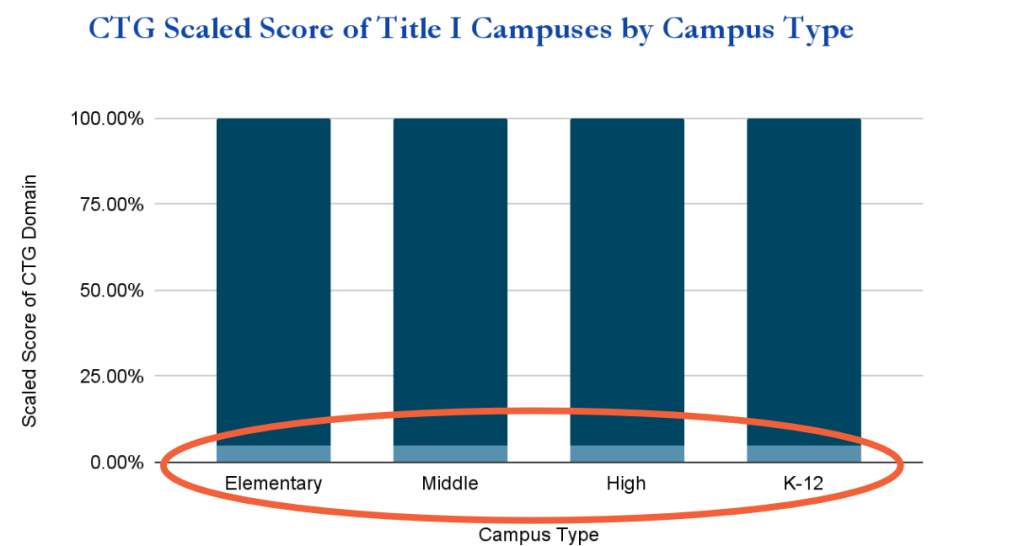The Every Student Succeeds Act (ESSA) requires state education agencies to determine low-performing schools. These low-performing schools are categorized under several names. These names include comprehensive support and improvement schools, targeted support and improvement schools, or additional targeted support. To align the identification of schools for improvement with the state’s accountability system, the Texas Education Agency (TEA) utilizes the Closing the Gaps domain. The Closing the Gaps domain uses disaggregated data to demonstrate differentials among racial/ethnic groups, socioeconomic backgrounds, and other factors. Let’s look closer at the first federal identification: Comprehensive Support and Improvement (CSI).
Campus Identification for CSI
Campuses are labeled as Comprehensive Support and Improvement (CSI) using two identifiers. To identify schools for CSI, TEA annually ranks all Title I campuses based on Closing the Gaps scaled scores.
First, TEA determines the bottom five percent of Closing the Gaps outcomes by rank-ordering the scaled scores of Title I campuses by school type. School types are elementary, middle, high school/ K–12, and alternative education accountability. Then, TEA determines which campuses fell in the bottom five percent for each school type. Title I campuses ranking in their school type’s bottom five percent are identified for CSI.
Additionally, if any Title I or non‐Title I campus does not attain a 66.7-67 percent six‐year federal graduation rate for the all-students group, the campus is identified for CSI.

Exiting CSI
In order for a campus to successfully exit CSI identification, a campus must meet two criteria.
- A campus must not rank in their school type’s bottom five percent of the Closing the Gaps domain for two consecutive years.
- A campus must have a Closing the Gaps domain scaled score, by the end of the second year, that is higher than when originally identified.
Campuses previously identified as CSI based solely on a low graduation rate below 67 percent must have a four or six-year federal graduation rate of at least 66.7 percent for two consecutive years to exit CSI status.
School Improvement Interventions
Once identified as comprehensive support and improvement, CSI campuses must actively participate in interventions.
The TEA works closely with the school, its district, and the assigned Education Service Center to help develop an Effective Schools Framework aligned targeted improvement plan. This plan outlines specific strategies and interventions that the school will implement to address its challenges.
Additionally, schools with CSI labels are subject to ongoing monitoring to track their progress toward improvement goals. The TEA assesses interventions regularly.
Conclusion
In summary, the Comprehensive Support and Improvement identification labels are a vital mechanism in Texas’ educational landscape. They target schools in need of additional support and interventions, promoting fairness and access to high-quality education for all students. TEA aims to empower struggling schools to improve their performance. Targeted interventions, resource allocation, and ongoing monitoring provide all students with the opportunity for success.
As Texas continues to refine the CSI identification it sets a precedent for other educational systems to follow suit. This promotes a future where every student has the opportunity to thrive.
For more information on School Improvement at ESC Region 13 visit their website. A-F Accountability information is available on their website or in additional blog topics.
Subscribe to the Accountability Weekly newsletter for the most up-to-date news and resources around A-F Accountability.
Melinda Marquez is the Director of Accountability, Assessment, and Leadership Systems here at ESC Region 13.






Hello,
This was a great video on Comp. Support & Improvement federal label. Is there another video on Targeted Suppport & Improvement and Additional Targeted Support?
If so, will you please share it.
Thank you,
Araceli
Hello, Araceli. Thanks for commenting. At this time, we do not have any other videos to recommend. Please check back on the blog because there will be more written on the subject in the coming months. In the meantime, you can contact Melinda Marquez, Director of Accountability, Assessment, and Leadership Systems, with additional questions.